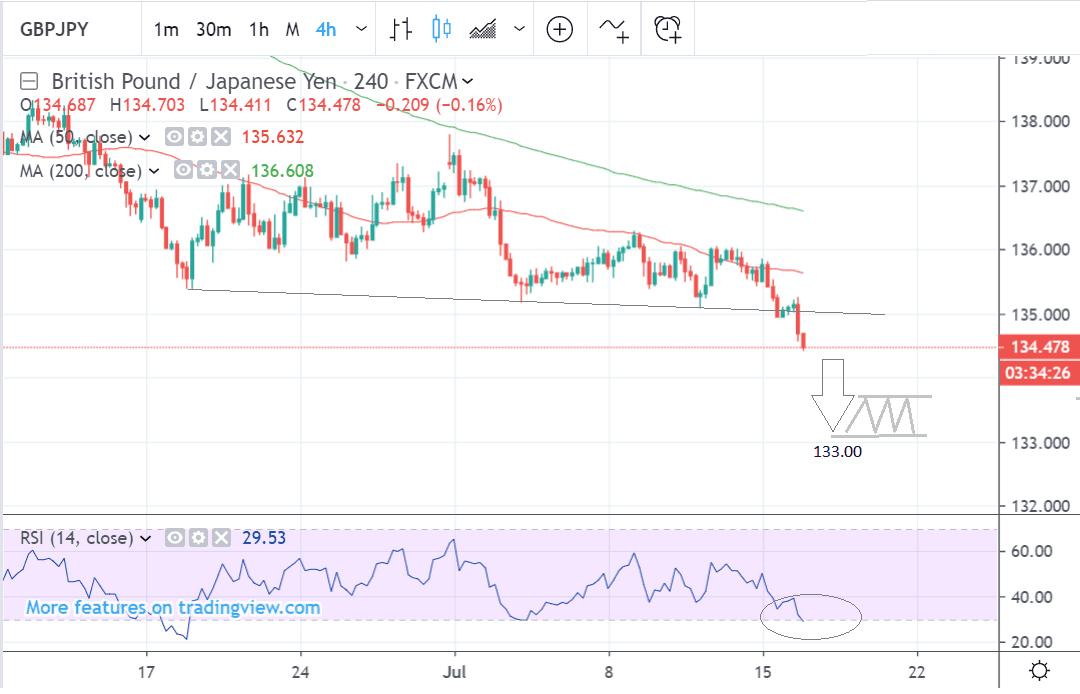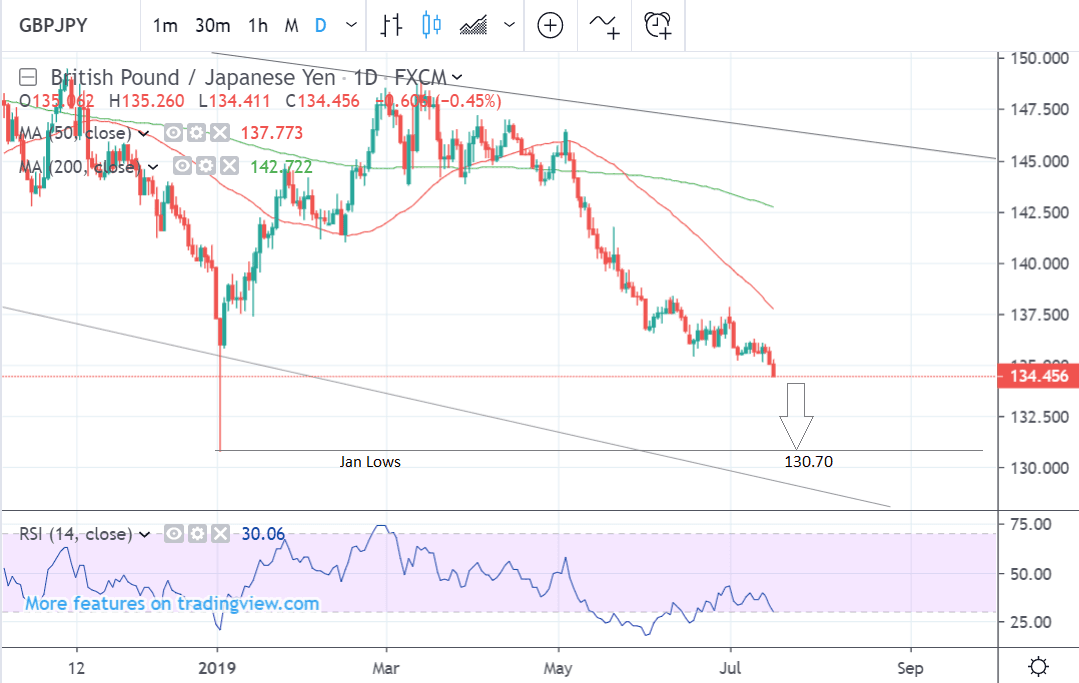Pound-Yen Rate in Sharp Decline, Downtrend Forecast to Extend Towards 2019 Low

Image © Adobe Stock
- GBP/JPY falling after break below key 135.00 level
- More downside to January lows now possible
- Yen to be driven by global risk trends and Brexit
The Pound-to-Yen exchange rate is trading at around 134.47 at the time of writing, already almost 1.0% down so far this week, and studies of the charts suggest the exchange rate will probably continue its downtrend in the days to come.
The 4-hour chart - used to determine the short-term outlook, which includes the coming week or next 5 days - shows how the pair has broken below key support at 135.00 and is now in steep decline.
The trend is clearly bearish and given the old adage that ‘the trend is your friend’ there is a continued downside bias.
The RSI momentum indicator in the lower pane is now just falling into oversold territory below 30 and this indicates a greater risk that the pair will pause and bounce.
Overall, however, the downtrend is so dominant that we expect it to continue substantially lower in the short-term, possibly, to a target at 133.00, and then probably pausing and trading sideways at that level for a while.
The daily chart shows the pair in a strong downtrend since the beginning of May and that this trend is expected to continue.
The break below the support level at 135.00 was key to reinvigorating the downtrend. We now see a probable extension down to a target at 130.70, and the January lows over the medium term.
If there is one fly in the ointment of an outright bearish forecast it is that the RSI indicator is at 30.06 which is close to oversold - defined as below 30. If it slips into oversold the risk the pair will stall and start going sideways will increase.
The daily chart is used to analyse the medium-term outlook which includes the next couple of weeks to a month.
The weekly chart shows the large wedge pattern which the pair has been forming since the start of 2018.
Although wedge patterns are generally considered as bullish the exchange rate is currently falling within the pattern after a false breakout at the start of the year.
The downtrend is so entrenched that we expect a continuation lower to the 130.70 target and then a probable bounce from here.
We use the weekly chart to give us an idea of the longer-term outlook, which includes the next few months.
Time to move your money? Get 3-5% more currency than your bank would offer by using the services of foreign exchange specialists at RationalFX. A specialist broker can deliver you an exchange rate closer to the real market rate, thereby saving you substantial quantities of currency. Find out more here. * Advertisement
The Japanese Yen: What to Watch
The main driver of the Yen is global investor risk appetite because it is a safe-haven currency.
The Yen actually gains when the outlook for the global economy worsens and investors grow fearful, equally, if the opposite happens and investors grow more confident on an improving outlook it weakens.
Data and events recently suggest investor sentiment remains cautious, benefiting the Yen.
The recent sharp downturn in GBP/JPY, for example, was probably driven by investor sentiment turning negative around Brexit after comments from the two prospective candidates in the conservative leadership contest - Boris Johnson and Jeremy Hunt - suggested their Brexit stances were hardening around the Irish backstop, indicating a higher chance of a ‘no-deal’ withdrawal.
As per our report, both Boris Johnson and Jeremy Hunt committed to binning the so-called Northern Irish backstop plan when they appeared before the cameras in the final debate of the Conservative Party leadership campaign.
That both Hunt and Johnson are now apparently rejecting the backstop in its entirety sends a signal to markets that the UK is on course for a 'no deal' exit, even if both candidates say they still want to find a negotiated settlement on the matter.
Another key driver of investor sentiment was Chinese growth data out on Monday.
The data showed growth slowing to 6.2% in Q2 in line with expectations and although this marked its lowest level since 1992, accompanying data for retail sales and industrial production, beat forecasts and gave a boost to sentiment as markets breathed a sigh of relief that the data hadn’t shown as hard a landing as had been feared.
Despite the fact that some commentators were sceptical about the source of the retail sales rebound, which Citibank said was “underpinned by a sharp rebound in auto consumption (+17%YoY) that appears rooted in aggressive discounting,” for example, the overall market mood improved, and if this trend for more 'neutral' Chinese data continues it will be negative for the Yen.
In reference to the GDP print, a good point was made by Jason Wong, an analyst at BNZ bank, who said that the data had to be seen in context of the rapid change in China's economy, and that although 6.2% was relatively low compared to historical rates, it was still relatively high in actual GDP volume terms, given China was now a much larger economy than it was previously.
“Of course, China’s economy is now significantly larger than more than a decade ago so a 6+% increase is a more meaningful contribution to the global economy than when it was growing at double-digit rates,” says Wong.
A further potential source of investor unease which could support the Yen is the outlook for Europe, which remains problematic.
Citibank analysts, for example, see the Eurozone economic slowdown as having got so bad that it will now warrant further monetary stimulus aid from the European Central Bank.
“ECB likely to ease, says Citi. Citi analysts expect 2Q-19 euro zone growth in manufacturing activity to be negative, after a strong 1Q (+0.9% QQ) and consistent with Citi’s baseline of slower euro zone real GDP growth of around 0.2% QQ in 2Q-19 after 0.4% QQ in 1Q-19. The Citi analysts’ baseline remains that the door to ECB QE will likely be reopened at the July 25 meeting together with the prospect of a 10bp rate cut (likely implemented at the September meeting),” says Citibank in a note.
Clearly, further easing in the Eurozone would weigh on the outlook for the global economy and potentially further drive up risk aversion and with it the Yen.
Time to move your money? Get 3-5% more currency than your bank would offer by using the services of foreign exchange specialists at RationalFX. A specialist broker can deliver you an exchange rate closer to the real market rate, thereby saving you substantial quantities of currency. Find out more here. * Advertisement


